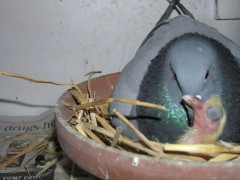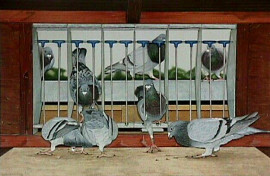Breeding
A racing pigeons home is called a loft. The loft must me clean, dry with proper ventilation. Three things that are relatively FREE but essential to health are: 1. Fresh Air 2. Sun light and 3. Clean water. Much has been written on the subject of loft construction. Before aquiring stock research this subject and build a loft to suit your tastes and the needs of your birds.
Most racing pigeons are sexually mature at 6 months of age they will mate and construct a nest if given proper material to do so. The hen will lay her first egg approximately 10 days after mating and lay a second egg 2 days later. Both the cock and the hen will incubate the eggs; generally the hen will sit on the eggs at night and the cock will sit on the eggs during the day. The eggs take 17 days to hatch after the second egg is laid. The newly hatched babies have no feathers, just a soft yellow down and are fed a cheesy substance called pigeon milk by both parents. At 10 days of age the parents begin feeding the babies grains. At 7-10 days the babies are banded on the leg just above the foot with a seemless band. The pair will mate for life unless a mate is removed, then a new partner will be chosen. The hen will lay another round of eggs approximately 3 weeks after the first round of eggs hatch. The young birds are weaned when fully feathered under their wings, approximately 4 weeks of age.
Training
SETTLING
Training begins at approximately 4 weeks of age when the young bird is fully feathered under its wings. The young bird is placed in a separate loft away from its parents; he is observed to ensure he is eating and drinking on his own. When the young bird is eating and drinking on his own he is taught the sound of meal times, most fanciers do this by shaking a can of grain when feeding. The young bird is settled to this new location by allowing him get to know his surroundings. After a few days the young bird is taught the trapping system aka the door in and out of the loft. He is also placed in settling cage on the landing board outside of the loft, which keeps the young bird from flying off and encourages him to get to know his surroundings, its' a big big world!
After a week or two of settling cage and trapping practice the traps are open and the young birds are allowed to go outside. It is best to let the young birds out alone, not with older birds. Also leave the birds hungry so they will be eager to trap when called and at about 2 hours prior to sunset. This process is done for approximately 2 weeks, teaching them to land and trap when called. The young birds will begin to loft fly. At first they may fly in every direction, but remember they have a strong flocking instinct and it won't be long before they are flying as a flock. During this time the young birds should be taught to land and trap after flying, not to loitter around on wires, neighbors roofs ect...
CONDITIONING
Once the young birds are flock flying and trapping well they should be let out in the mornings for exercise. Continue to reinforce good habits of landing and trapping. The young birds should not be given "open loft", allowed to come and go anytime, because of the risk of eating bugs off the ground and getting internal parasites or eating fertilizer and dying, not to mention attracting predators. This is phase of conditioning will last 2-8 weeks.
ROAD TRAINING
Young birds enter the training phase when they begin to "route/trip", when the young birds are let out for excercise the flock flies away for hours. It is at this point that road training begins. There are many theories on road training, but in a nut shell it consists of taking the youngbirds progressively farther distances from home. This is done to hone their homing instinct, build the young birds confidence and for physical conditioning. During this phase the young birds health must be watched closely and accurate records kept on the performance of each bird. In between training days the young birds continue to get morning loft exercise and might even get evening exercise as well, they should be flying at least 1 hour. Remember pigeons are cardiovascular machines who love to fly. Many successful fanciers do not begin road training in earnest until 6-8 weeks prior to the first race.




